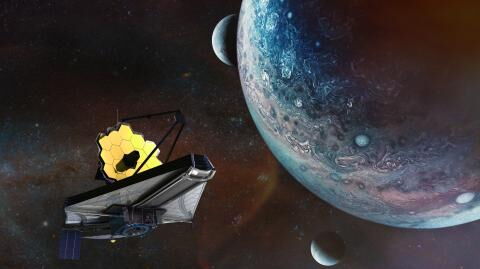What might life outside Earth be like? Thanks to its tools, and in particular the James Webb Space Telescope, NASA scans the Cosmos for planets similar to our own. The possibility of life on a planet other than Earth depends on a rather miraculous number of factors: its distance from its star (the famous habitable zone), the composition of its atmosphere, temperature, size and so on. While observing a planet orbiting the star K2-12, the space telescope made a discovery that greatly intrigued astronomers.
Discover our latest podcast
K2-18 b, a super-Earth 120 light-years away
This (exo-)planet is called K2-18 b, a planet relatively close to us. 8.6 times more massive than the Earth, K2-18 b is between the size of Neptune and our planet, so it can be described as a super-Earth or sub-Neptune.
According to NASA observations, K2-18 b is a hyanate planet, a rare, potentially habitable type of planet with massive oceans beneath a hydrogen-rich atmosphere. Hyatanic planets do not exist in our Solar System, but are very common in the Milky Way. NASA states in a press release:
Traditionally, the search for life on exoplanets has focused mainly on small, rocky planets, but larger Hycéanic worlds are much more conducive to atmospheric observation.
Read more:NASA releases new photos of Mars illuminated by the sun
K2-18 b capable of harboring life? Not necessarily
If K2-18 b has attracted the attention of astronomers, it's because it could present 'potential proof of life'. Specifically, James Webb's first observations indicate the potential detection of dimethyl sulfide (DMS). Now, this compound - reputedly malodorous - is only produced by living organisms as far as we know... Or at least on Earth.
Further observations are needed to confirm this potential detection, and NASA emphasizes that this does not necessarily mean that K2-18 b harbors life:
The planet's large size - with a radius 2.6 times that of Earth - means that its interior probably contains a large high-pressure ice mantle, like Neptune, but with a thinner, hydrogen-rich atmosphere, and an oceanic surface. Oceanic worlds are thought to have oceans of water. However, it's also possible that the ocean is too hot to be habitable or liquid.
The Webb telescope has detected carbon dioxide and methane in the atmosphere of exoplanet K2-18 b, a potentially habitable world over 8 times bigger than Earth. Webb’s data suggests the planet might be covered in ocean, with a hydrogen-rich atmosphere: https://t.co/qN1SqCfFt1pic.twitter.com/yoXF3flsUl
— NASA Webb Telescope (@NASAWebb) September 11, 2023
Read more:NASA's James Webb Space Telescope reveals a new exoplanet with CO2, is it habitable for humans?
This article has been translated from Gentside FR.
Source used:
NASA: Webb Discovers Methane, Carbon Dioxide in Atmosphere of K2-18 b















